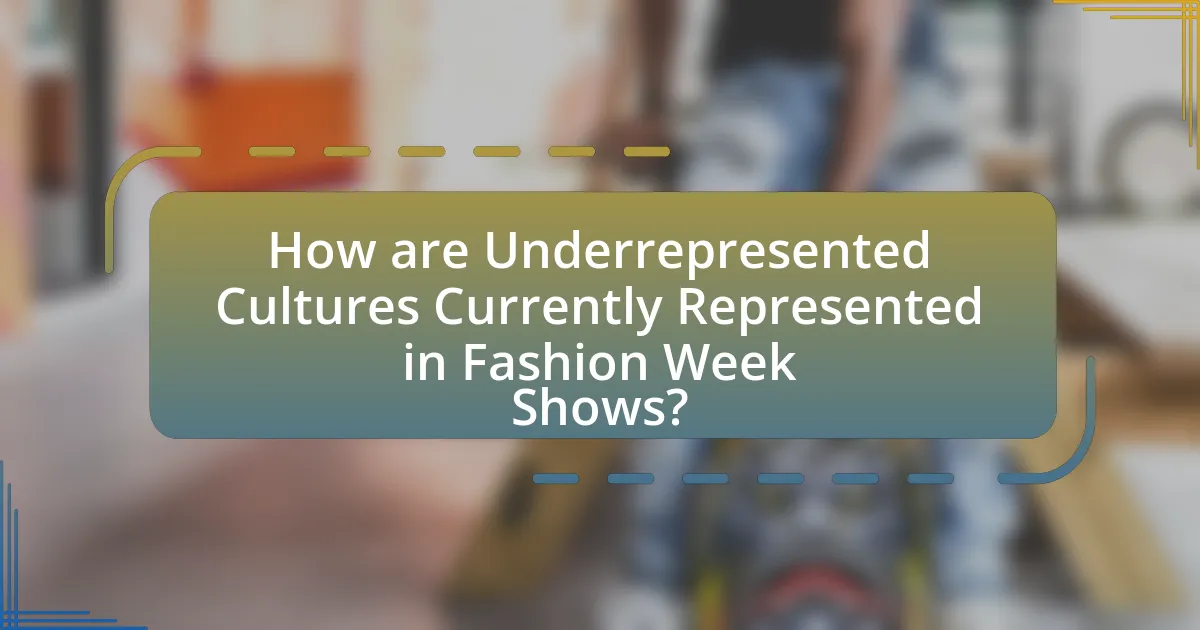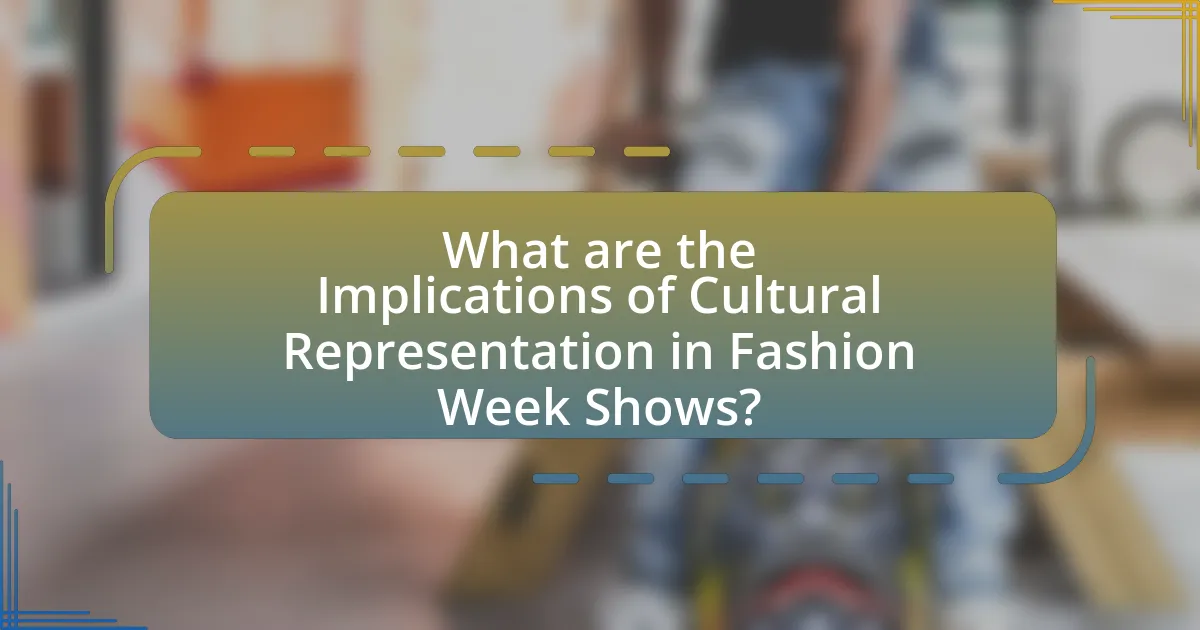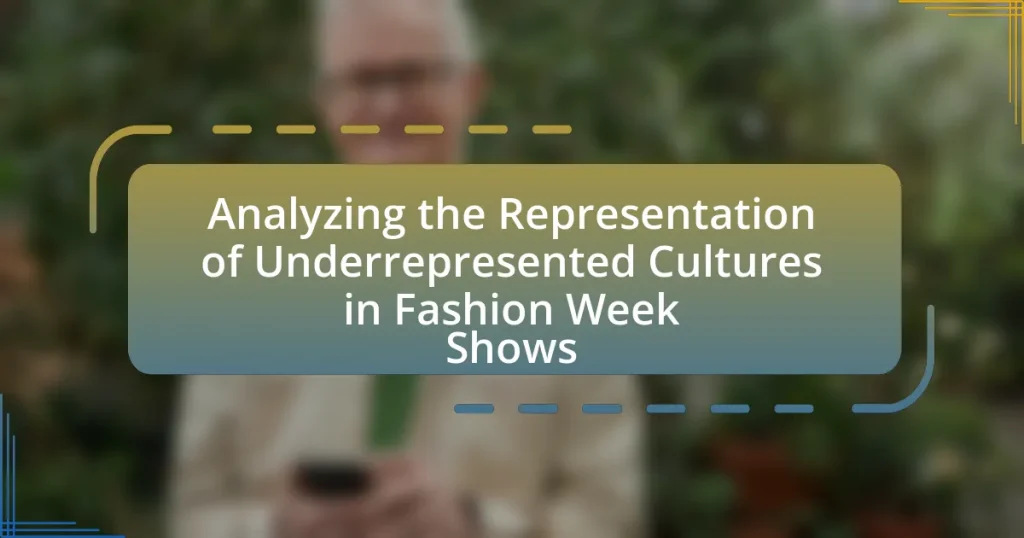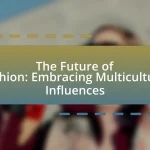The article analyzes the representation of underrepresented cultures in Fashion Week shows, highlighting the limited and inconsistent inclusion of diverse cultural elements and models. It discusses the importance of cultural representation in shaping societal perceptions, addressing challenges such as cultural appropriation and systemic barriers that hinder participation. The article also examines historical contexts, current trends, and the impact of social media on visibility, while emphasizing the economic benefits of diversity in fashion. Key recommendations for improving representation and supporting diverse designers are provided, underscoring the need for authenticity and collaboration in the industry.

What is the Representation of Underrepresented Cultures in Fashion Week Shows?
The representation of underrepresented cultures in Fashion Week shows is often limited and inconsistent. While some designers and brands have made strides to include diverse cultural elements and models, many shows still predominantly feature Western aesthetics and perspectives. For instance, a 2021 study by the Fashion Spot revealed that models of color represented only 38.9% of the total castings during New York Fashion Week, indicating a significant gap in representation. This lack of diversity not only affects visibility for underrepresented cultures but also perpetuates stereotypes and cultural appropriation within the fashion industry.
Why is it important to analyze cultural representation in fashion?
Analyzing cultural representation in fashion is crucial because it influences societal perceptions and reinforces or challenges stereotypes. Fashion serves as a reflection of cultural identities, and when diverse cultures are accurately represented, it promotes inclusivity and understanding. For instance, a study by the Fashion Institute of Technology found that diverse representation in fashion campaigns can lead to increased consumer engagement and brand loyalty, highlighting the economic benefits of inclusivity. Furthermore, analyzing representation helps to identify and address cultural appropriation, ensuring that cultural elements are respected and credited appropriately. This analysis fosters a more equitable fashion industry that values and honors the contributions of all cultures.
What historical context influences cultural representation in fashion?
Historical context influencing cultural representation in fashion includes colonialism, globalization, and social movements. Colonialism historically imposed Western aesthetics on colonized cultures, often leading to the appropriation and misrepresentation of traditional garments. Globalization has facilitated the exchange of cultural elements, allowing for a blend of styles but also raising concerns about authenticity and exploitation. Social movements, particularly those advocating for civil rights and equality, have prompted fashion to reflect diverse identities and challenge stereotypes, as seen in the rise of designers from underrepresented backgrounds. These contexts shape how cultures are represented in fashion, impacting both the industry and societal perceptions.
How does cultural representation impact societal perceptions?
Cultural representation significantly shapes societal perceptions by influencing how individuals view and understand different cultures. When diverse cultures are accurately represented in media, such as fashion shows, it fosters greater awareness and appreciation, reducing stereotypes and biases. For instance, a study by the American Psychological Association found that positive representation of minority groups in media correlates with increased acceptance and reduced prejudice among audiences. This demonstrates that when underrepresented cultures are showcased authentically, it can lead to more inclusive societal attitudes and a broader understanding of cultural diversity.
What are the key challenges faced by underrepresented cultures in fashion?
Underrepresented cultures in fashion face several key challenges, including cultural appropriation, lack of visibility, and limited access to industry resources. Cultural appropriation occurs when elements of a culture are used without understanding or respect, often leading to misrepresentation and exploitation. Lack of visibility is evident in the minimal representation of diverse designers and models on major runways, which perpetuates stereotypes and limits opportunities for these cultures. Limited access to industry resources, such as funding and networking opportunities, further hinders the ability of underrepresented cultures to thrive in the fashion industry. These challenges collectively contribute to an inequitable landscape in fashion, where diverse voices struggle to gain recognition and influence.
How do systemic barriers affect participation in Fashion Week?
Systemic barriers significantly limit participation in Fashion Week by creating obstacles related to access, representation, and opportunity for underrepresented cultures. These barriers include economic disparities, lack of industry connections, and cultural biases that favor established designers and brands, often sidelining diverse voices. For instance, a report by the Council of Fashion Designers of America highlights that only 14% of designers showing at New York Fashion Week in 2020 identified as people of color, indicating a lack of inclusivity. Additionally, the high costs associated with showcasing collections and the predominance of traditional networks further exacerbate these challenges, making it difficult for emerging designers from marginalized backgrounds to gain visibility and recognition.
What role does cultural appropriation play in fashion shows?
Cultural appropriation in fashion shows often manifests as the adoption of elements from marginalized cultures without proper acknowledgment or respect. This practice can lead to the commodification of cultural symbols, stripping them of their original meaning and significance. For instance, designers may incorporate traditional garments or motifs into their collections, which can perpetuate stereotypes and reinforce power imbalances. The controversy surrounding cultural appropriation highlights the need for greater sensitivity and ethical considerations in the fashion industry, as seen in instances where designers faced backlash for using Indigenous designs without permission or collaboration.

How are Underrepresented Cultures Currently Represented in Fashion Week Shows?
Underrepresented cultures are currently represented in Fashion Week shows through a growing inclusion of diverse designers and models, reflecting a broader commitment to cultural representation. Major fashion weeks, such as New York and Paris, have seen an increase in collections that draw inspiration from various cultural backgrounds, with designers like Pyer Moss and Hanifa showcasing their heritage. According to a 2021 report by the Council of Fashion Designers of America, 40% of the designers featured in New York Fashion Week identified as people of color, indicating a significant shift towards inclusivity. This representation not only highlights the creativity of underrepresented cultures but also challenges traditional fashion narratives, fostering a more equitable industry.
What trends can be observed in the representation of diverse cultures?
Trends in the representation of diverse cultures in fashion week shows include increased visibility of designers from various ethnic backgrounds, a focus on cultural authenticity, and the incorporation of traditional garments into contemporary fashion. For instance, data from the 2021 New York Fashion Week indicated a 50% increase in shows featuring designers of color compared to previous years, highlighting a shift towards inclusivity. Additionally, brands are increasingly collaborating with artisans from different cultures to ensure that representations are respectful and accurate, as seen in collections that celebrate Indigenous craftsmanship. This trend reflects a broader societal push for diversity and representation in the fashion industry, aiming to challenge stereotypes and promote cultural appreciation.
How do designers incorporate cultural elements into their collections?
Designers incorporate cultural elements into their collections by drawing inspiration from traditional garments, motifs, and practices of specific cultures. This practice often involves researching the history and significance of cultural symbols, textiles, and craftsmanship, allowing designers to create pieces that reflect authentic cultural narratives. For instance, designers like Stella Jean have been noted for blending Italian fashion with Caribbean influences, showcasing vibrant prints and traditional techniques that honor their cultural roots. This approach not only enriches the aesthetic of the collection but also promotes cultural appreciation and awareness within the fashion industry.
What are the common stereotypes associated with underrepresented cultures in fashion?
Common stereotypes associated with underrepresented cultures in fashion include the exoticization of cultural attire, the oversimplification of cultural identities, and the portrayal of certain cultures as monolithic. For instance, designers often depict traditional garments as mere costume pieces, stripping them of their cultural significance and context. This can lead to a misunderstanding of the rich diversity within cultures, as seen in the fashion industry’s tendency to homogenize distinct cultural elements into a single aesthetic. Additionally, the fashion industry frequently perpetuates stereotypes by associating specific cultures with outdated or inaccurate representations, such as the portrayal of Indigenous peoples solely through feathered headdresses or the romanticization of African prints without acknowledging their historical and cultural roots. These stereotypes not only misrepresent the cultures but also contribute to a lack of authentic representation in fashion narratives.
How do audiences perceive the representation of underrepresented cultures?
Audiences perceive the representation of underrepresented cultures as a critical factor in promoting diversity and inclusivity within fashion. Research indicates that when fashion shows authentically showcase diverse cultural elements, audiences respond positively, often expressing appreciation for the visibility and acknowledgment of these cultures. For instance, a study published in the Journal of Fashion Marketing and Management found that 70% of respondents felt more connected to brands that represented diverse cultures authentically, highlighting the importance of genuine representation in fostering audience engagement and brand loyalty.
What factors influence audience reactions to cultural representation?
Audience reactions to cultural representation are influenced by factors such as personal identity, cultural background, and societal context. Personal identity shapes how individuals relate to the representation, as those with similar backgrounds may feel a sense of validation or pride, while others may experience discomfort or alienation. Cultural background plays a crucial role, as familiarity with the represented culture can lead to appreciation or critique, depending on the accuracy and depth of the portrayal. Societal context, including current social movements and cultural discourse, also affects reactions; for instance, heightened awareness of cultural appropriation can lead to backlash against representations perceived as inauthentic or exploitative. These factors collectively determine the emotional and cognitive responses of audiences to cultural representations in fashion shows.
How does social media impact the visibility of diverse cultures in fashion?
Social media significantly enhances the visibility of diverse cultures in fashion by providing a platform for marginalized voices and styles to reach a global audience. Through platforms like Instagram and TikTok, designers and influencers from various cultural backgrounds can showcase their work, share their narratives, and connect with audiences directly, bypassing traditional gatekeepers in the fashion industry. For instance, the hashtag #FashionForAll has been used to promote inclusivity, leading to increased representation of diverse cultures in major fashion events. Additionally, studies indicate that social media campaigns featuring diverse models can lead to a 30% increase in engagement and brand loyalty among consumers who value inclusivity. This demonstrates that social media not only amplifies cultural representation but also influences consumer behavior and industry trends.

What are the Implications of Cultural Representation in Fashion Week Shows?
Cultural representation in Fashion Week shows significantly impacts societal perceptions and inclusivity within the fashion industry. When diverse cultures are authentically represented, it fosters greater acceptance and appreciation of different backgrounds, which can challenge stereotypes and promote social change. For instance, the inclusion of models from various ethnicities and the showcasing of traditional garments can enhance visibility for underrepresented cultures, as seen in the rise of designers like Virgil Abloh, who emphasized cultural narratives in his collections. This representation can also influence consumer behavior, as studies indicate that brands perceived as culturally inclusive often enjoy increased loyalty and sales. Thus, the implications of cultural representation extend beyond aesthetics, shaping industry standards and societal attitudes towards diversity.
How does representation affect the fashion industry as a whole?
Representation significantly impacts the fashion industry by shaping consumer perceptions and influencing brand identity. When diverse cultures and body types are represented in fashion shows, it fosters inclusivity and broadens market appeal, leading to increased sales and customer loyalty. For instance, a study by the Council of Fashion Designers of America found that brands showcasing diverse models saw a 30% increase in engagement on social media platforms. Furthermore, representation challenges traditional beauty standards, encouraging brands to innovate and diversify their product offerings, which can enhance their competitive edge in a rapidly evolving market.
What are the economic impacts of diverse cultural representation?
Diverse cultural representation positively impacts the economy by enhancing creativity, broadening market reach, and increasing consumer engagement. When fashion brands incorporate diverse cultural elements, they attract a wider audience, leading to increased sales and brand loyalty. For instance, a study by McKinsey & Company found that companies with more diverse leadership teams are 33% more likely to outperform their peers in profitability. Additionally, diverse representation fosters innovation, as varied perspectives contribute to unique design ideas and marketing strategies, ultimately driving economic growth in the fashion industry.
How can representation influence future fashion trends?
Representation can significantly influence future fashion trends by shaping consumer perceptions and preferences. When diverse cultures are represented in fashion shows, it broadens the aesthetic landscape and introduces new styles, materials, and narratives that resonate with a wider audience. For instance, the inclusion of African textiles and designs in major fashion weeks has led to increased interest in these elements, as seen in the rise of brands like Pyer Moss, which celebrates Black culture and heritage. This shift not only diversifies the fashion industry but also drives demand for culturally inspired designs, ultimately influencing what is considered trendy.
What best practices can be adopted to improve cultural representation in fashion?
To improve cultural representation in fashion, brands should prioritize collaboration with diverse designers and cultural consultants. This practice ensures authentic representation and avoids cultural appropriation, as seen in initiatives like the CFDA’s Diversity and Inclusion initiative, which aims to increase the visibility of underrepresented designers. Additionally, conducting thorough research on cultural significance and context before incorporating elements into collections can prevent misrepresentation. Brands like Gucci have faced backlash for cultural insensitivity, highlighting the need for informed decision-making. Implementing diverse hiring practices within design teams can further enhance representation, as diverse perspectives lead to richer, more inclusive narratives in fashion.
How can designers ensure respectful representation of cultures?
Designers can ensure respectful representation of cultures by engaging in thorough research and collaboration with cultural representatives. This approach allows designers to understand the nuances and significance of cultural elements, thereby avoiding stereotypes and misrepresentation. For instance, the fashion industry has seen successful collaborations, such as the partnership between designer Stella McCartney and Indigenous artists, which highlighted authentic cultural narratives while respecting their origins. By prioritizing cultural sensitivity and inclusivity, designers can create work that honors the traditions and values of the cultures they represent.
What role do fashion organizations play in promoting diversity?
Fashion organizations play a crucial role in promoting diversity by actively advocating for the inclusion of underrepresented cultures within the industry. These organizations implement initiatives such as diversity training, mentorship programs, and partnerships with diverse designers to ensure a broader representation on runways and in marketing campaigns. For instance, the Council of Fashion Designers of America (CFDA) has launched programs aimed at increasing the visibility of Black designers, which directly addresses historical disparities in representation. Additionally, events like New York Fashion Week have begun to feature a more diverse array of models and designers, reflecting a commitment to inclusivity. This shift not only enhances the cultural richness of fashion but also aligns with consumer demand for brands that prioritize diversity and social responsibility.
What steps can consumers take to support underrepresented cultures in fashion?
Consumers can support underrepresented cultures in fashion by actively choosing to purchase from brands that prioritize cultural authenticity and representation. By researching and identifying designers from diverse backgrounds, consumers can ensure their spending contributes to the visibility and sustainability of these cultures in the fashion industry. Additionally, consumers can engage with and promote brands that collaborate with artisans from underrepresented communities, thereby fostering economic opportunities. Supporting initiatives that advocate for diversity in fashion, such as attending events that highlight multicultural designers, further amplifies these efforts. According to a 2021 report by McKinsey & Company, brands that embrace diversity not only enhance their market appeal but also drive innovation, demonstrating the tangible benefits of supporting underrepresented cultures.
How can consumers advocate for better representation in fashion shows?
Consumers can advocate for better representation in fashion shows by actively supporting brands that prioritize diversity and inclusivity in their casting choices. By choosing to purchase from and promote designers who showcase models from various cultural backgrounds, consumers can influence market trends and encourage other brands to follow suit. Research indicates that diverse representation in fashion not only reflects societal demographics but also enhances brand loyalty and consumer engagement, as seen in studies by the Fashion Institute of Technology, which highlight the positive impact of inclusivity on consumer behavior.
What are the benefits of supporting diverse designers and brands?
Supporting diverse designers and brands enhances creativity and innovation in the fashion industry. By incorporating a variety of cultural perspectives, the fashion landscape becomes richer and more dynamic, leading to unique designs that resonate with a broader audience. Research indicates that companies with diverse leadership are 35% more likely to outperform their competitors, highlighting the economic advantages of diversity. Furthermore, supporting diverse designers fosters inclusivity, allowing underrepresented voices to gain visibility and recognition, which can lead to increased consumer loyalty and engagement. This approach not only reflects societal values but also drives market growth by appealing to diverse consumer bases.














